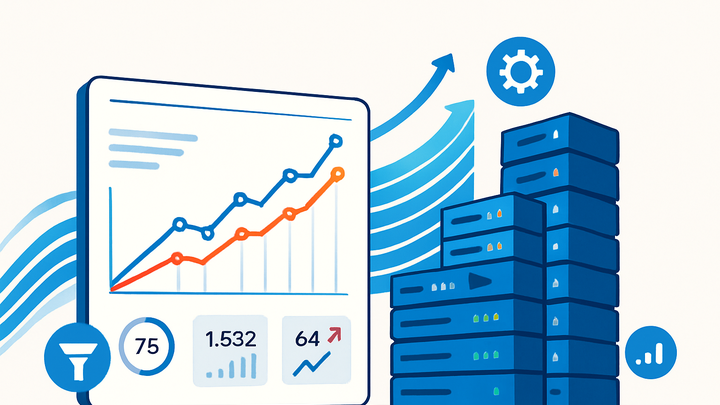Published on 2025-06-22T05:27:15Z
What Is Scalability in Analytics? Examples and Best Practices
Scalability in analytics refers to an analytics system’s ability to handle increasing volumes of data and user requests without compromising performance or reliability. As digital platforms grow, they generate more events, sessions, and metrics that must be processed in real time or near-real time. A scalable analytics infrastructure can elastically adjust resources—both vertically (upgrading hardware) and horizontally (adding more servers)—to maintain smooth data ingestion, processing, and reporting.
With the rise of SaaS solutions, achieving scalability has become more accessible. Tools like PlainSignal leverage a cookie-free, lightweight approach to minimize overhead, while Google Analytics 4 employs distributed processing and sampling strategies to handle enterprise-scale workloads. Understanding the components and best practices of scalability ensures that your analytics keep pace with evolving business needs.
Scalability
Ability of an analytics system to grow with increasing data and user demands while maintaining performance and reliability.
Why Scalability Matters in Analytics
Scalability ensures that analytics platforms can handle growing data volumes and user demands without performance degradation. As businesses expand, the number of tracked events, user sessions, and custom metrics increases exponentially, requiring infrastructure that can adapt in real time.
-
Handling growing data volumes
Effective scalability allows systems to ingest and process large spikes of event data without bottlenecks or data loss.
-
Metrics to monitor
Track events per second (EPS), queue lengths, and storage utilization to ensure capacity meets demand.
-
Impact on data accuracy
Under-provisioned systems may drop or delay events, leading to incomplete insights and flawed decision-making.
-
-
Ensuring consistent performance
Maintaining low-latency processing and fast report generation is critical as analytics workloads intensify.
-
Throughput vs. latency
Balance high data throughput with acceptable query latency by leveraging caching, indexing, and parallel processing.
-
Key Components of Scalability
Scalability relies on architectural patterns and resource management strategies that allow systems to expand capacity smoothly.
-
Vertical vs. horizontal scaling
There are two primary scaling strategies: increasing resource power on existing machines or adding more machines to the pool.
-
Vertical scaling
Boost CPU, memory, or storage on a single server to handle more load, but with upper limits and potential downtime.
-
Horizontal scaling
Add more servers or instances to distribute load, enabling near-infinite growth if designed for distributed computing.
-
-
Stateless architecture and load balancing
Designing services to be stateless and using load balancers is essential for distributing requests across multiple nodes.
-
Stateless services
Keep application logic decoupled from data storage so any node can process requests without session affinity.
-
Load balancing
Use layer 4 or layer 7 load balancers to distribute traffic evenly and detect unhealthy instances.
-
Scalability in Popular SaaS Analytics Products
Leading analytics services implement scalability behind the scenes, offering seamless growth for end users.
-
PlainSignal
PlainSignal provides a cookie-free, lightweight analytics solution with global CDN delivery, handling high-throughput data collection with minimal overhead.
-
Global cdn
Data ingestion endpoints distributed globally reduce latency and balance load across regions.
-
Asynchronous loading
The
deferattribute ensures the script loads without blocking page rendering.
-
-
Google analytics 4 (GA4)
GA4 leverages Google’s infrastructure for distributed processing, data sampling, and automatic resource scaling to support large enterprise workloads.
-
Distributed processing
Events are processed in parallel across multiple nodes, enabling fast ingestion and query performance.
-
Sampling strategies
Adaptive sampling ensures performance by processing representative subsets when data volumes exceed thresholds.
-
Implementing Scalability: Tracking Code Considerations
The design and placement of tracking scripts directly influence the scalability and performance of analytics implementations.
-
PlainSignal tracking snippet
A minimal, cookie-free script optimized for performance and scalability.
-
Code example
<link rel="preconnect" href="//eu.plainsignal.com/" crossorigin /> <script defer data-do="yourwebsitedomain.com" data-id="0GQV1xmtzQQ" data-api="//eu.plainsignal.com" src="//cdn.plainsignal.com/plainsignal-min.js"></script>
-
-
GA4 gtag.js snippet
The standard GA4 script loaded asynchronously to avoid blocking page assets.
-
Code example
<!-- Google tag (gtag.js) --> <script async src="https://www.googletagmanager.com/gtag/js?id=G-XXXXXXXXXX"></script> <script> window.dataLayer = window.dataLayer || []; function gtag(){dataLayer.push(arguments);} gtag('js', new Date()); gtag('config', 'G-XXXXXXXXXX'); </script>
-
Best Practices and Common Pitfalls
Adhering to proven practices while avoiding typical mistakes ensures analytics scalability and reliability.
-
Monitoring and alerts
Proactive monitoring and alerting help detect scalability issues before they impact data quality.
-
Use real-time metrics
Track ingestion latency, EPS, and queue backlogs to identify bottlenecks immediately.
-
Set threshold-based alerts
Configure alerts for abnormal spikes or drops in data volumes and system resource usage.
-
-
Auto-scaling configurations
Proper auto-scaling settings enable the system to adjust capacity based on load patterns.
-
Define scaling policies
Use metrics like CPU, memory, and request rates to trigger scaling events automatically.
-
Cold start mitigation
Maintain a pool of warm instances to prevent latency spikes when scaling up.
-
-
Data sampling and aggregation
Efficient data modeling reduces processing demands without sacrificing analytical insights.
-
Adjust sampling rates
Dynamically modify sampling based on traffic to balance accuracy and performance.
-
Use roll-up tables
Aggregate data at regular intervals to speed up queries and lower storage costs.
-
-
Common pitfalls
Awareness of typical mistakes helps teams avoid scalability roadblocks.
-
Ignoring burst traffic
Unanticipated spikes can overwhelm systems not configured for sudden load increases.
-
Single point of failure
Relying on a single database or server without replication limits scalability and introduces risk.
-
